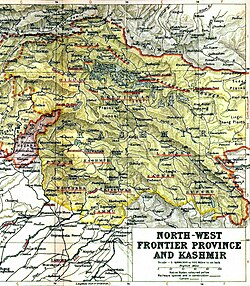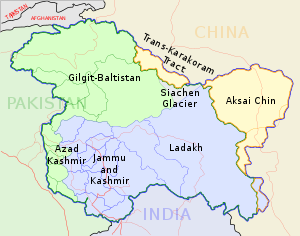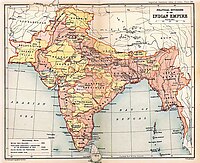| Jammu and Kashmir | ||||||
| Princely State of India | ||||||
|
||||||
|
||||||
| Map of Kashmir | ||||||
| Historical era | New Imperialism | |||||
| • | Princely state of British India | 1846 | ||||
| • | technically independent | 15 Aug 1947 | ||||
| • | First Kashmir War (cession of Azad Kashmir and Gilgit-Baltistan) | 22 Oct 1947 | ||||
| • | Accession to Indian Union | 26 Oct 1947 | ||||
| • | Monarchy abolished | 1952 | ||||
| Today part of | China, India and Pakistan | |||||
At the time of the British withdrawal from India, Maharaja Hari Singh, the ruler of the state, preferred to become independent and remain neutral between the successor dominions of India and Pakistan.[3] However, an uprising in the western districts of the State followed by an attack by raiders from the neighbouring Northwest Frontier Province, supported by Pakistan, put an end to his plans for independence. On 26 October 1947, the Maharaja signed the Instrument of Accession joining the Dominion of India in return for military aid.[4] The western and northern districts presently known as Azad Kashmir and Gilgit-Baltistan passed to the control of Pakistan.[5]
Establishment
Jammu and Kashmir (princely state)
In 1808, Jammu itself was annexed to the Sikh Empire by Maharaja Ranjit Singh, the son of Mahan Singh.[9]
Gulab Singh, Dhruv Dev's direct descendant, was 16 years old when Jammu was annexed to the Sikh Empire. Gulab Singh and his two brothers, Dhyan Singh and Suchet Singh, went on to enrol in the Sikh troops. Gulab Singh soon distinguished himself in battles, and was awarded a Jagir near Jammu and allowed to keep an independent force. After the conquest of Kishtwar (1821) and the subjugation of Rajouri, he was made a hereditary Raja of Jammu in 1822, with an annual allowance of 300,000 rupees. Ranjit Singh personally anointed him as the Raja. His brother Dhyan Singh received Poonch and Suchet Singh Ramnagar.[10][11]
By 1827, Gulab Singh brought under his control all the principalities lying between Kashmir and Jammu.[12] Dhyan Singh became the Lord Chamberlain and, later, Prime Minister for Ranjit Singh. Gulab Singh acquired fame in the Sikh court as a warrior and an able manager of the State's affairs.[13]
Acquisition of Ladakh
The conquest of Kishtwar meant that Singh had gained control of two of the roads which led into Ladakh, which then led to the conquest of that territory. Although there were huge difficulties due to the mountains and glaciers, Gulab Singh's Dogra troop under his general Zorawar Singh Kahluria conquered the whole of Ladakh in two campaigns.[14]A few years later, in 1840, Zorawar Singh invaded Baltistan, captured the Raja of Skardu, who had sided with the Ladakhis, and annexed his country to Gulab Singh's kingdom. In 1841 Zorawar Singh invaded Tibet, but perished with nearly his entire army in the harsh winter. Whether it was by policy or accident, by 1840 Gulab Singh had encircled Kashmir.[14]
Anglo-Sikh War
Gulab Singh, the founder and the first Maharaja of the princely state of Jammu & Kashmir.
On the eve of the First Anglo-Sikh War (1845–1846), the relations between Gulab Singh and the Sikh Darbar were severely strained. Robert Huttenback states that Gulab Singh, as well as the British East India Company, had anticipated that the Sikh power would collapse after the death of Ranjit Singh and Gulab Singh positioned himself to become an independent ruler in due course.[18] He also maintained friendly relations with the Company and had no intention of jeopardising them for the sake of the anarchic Sikh Darbar. On the other hand, The Sikh army had no trust in any of the Sikh commanders in Lahore and asked for Gulab Singh to lead them. This, Gulab Singh refused to do. He counselled alliance with the British instead, and pursued his own communications with the British, seeking reassurance that his Jagirs would not be disturbed.[19]
Indus river and tributaries
Creation of Jammu and Kashmir
Indus river and tributaries
Flag of J&K (1846–1936)
Flag of Maharaja of J&K (1846–1936)
Lahore however instructed its governor of Kashmir, Sheikh Imam Uddin, to resist the hand-over of Kashmir. Wazir Lakhpat, who was sent to take control of Kashmir, was killed by the Sikh army in occupation. Gulab Singh also faced rebellions in the provinces of Rajouri and Rampur. Beset by all sides, Gulab Singh appealed to the British to implement its treaty obligations. Subsequently, a combined force from Lahore, the British and the Dogras arrived in Kashmir and acquired the surrender of Kashmir. Wazir Lal Singh of the Sikh Darbar was dismissed for inciting rebellions. Gulab Singh entered Srinagar on 9 November 1846 as the Maharaja of Jammu and Kashmir.[24]CITEREFMajor.2C_Return_to_Empire1981
Territorial adjustments
Following a rebellion in Hazara, Gulab Singh asked for an exchange of Hazara for other territories. Consequently, Hazara was transferred back to Lahore and Gulab Singh received Kathua and Suchetgarh and part of Minawar in exchange. In 1847, Sujanpur and part of Pathankot were handed over to the British in lieu of pensions to disinherited hill chiefs.[25]The sons of Dhyan Singh, Jawahir Singh and Moti Singh, put forward a claim to Poonch, on the grounds that it was the Jagir of their father, and to Jasrota, which was earlier a Jagir of their brother Hira Singh. After negotiation, the British granted them Chalayar and Watala as Jagirs with the title of Raja. They were to give the Maharaja Gulab Singh a horse with gold trappings every year and consult him on matters of importance. In 1852, Poonch was granted to Moti Singh as a Jagir on the same conditions.[26]
The Raja of the Chamba State (which became part of Gulab Singh's territories by the Treaty of Amritsar) put forward a claim that Bhadarwah was a Jagir granted to him by the Maharaja Ranjit Singh. Since the situation was anomalous, the British let Bhadarwah be retained by Gulab Singh but allowed Chamba to be separated in a subsidiary alliance with the British Government.[27]
The settlement of the boundary between Ladakh and Tibet was carried out by Alexander Cunningham with the assistance of Henry Strachey and Dr. Thomson in 1847. Thus the present borders of the princely state were finalised.[28]
Gilgit
Map of the Jammu and Kashmir state, Edward Stanford Ltd., 1885
Gulab Singh died in 1857. His successor, Ranbir Singh, loyally sided with the British in the Indian Rebellion of 1857. When Kashmir had recovered from the strain of the Rebellion. Ranbir Singh determined to recover Gilgit and to expand the frontier. In 1860 a force under Devi Singh crossed the Indus, and advanced on Gaur Rahman's fortress at Gilgit. Gaur Rahman had died just before the arrival of the Dogras, and Gilgit was taken.[29] Gilgit was not the last frontier, however. Ranbir attempted to conquer Yasin and Punial, but failed due to lack of funds. To make a secure frontier, he withdrew his forces to Gilgit. Kashmir and Jammu held Gilgit until the partition of India in 1947.[30]
Ranbir Singh, although tolerant of other creeds, lacked his father's strong will and determination, and his control over the State officials was weak. The latter part of his life was darkened by the dreadful famine in Kashmir, 1877–1879. In September 1885, he was succeeded by his eldest son, Pratap Singh.[29]
Pratap Singh defeated the ruler of Chitral in 1891, and forced Hunza and Nagar to accept the suzerainty of Kashmir and Jammu state.[31]
Administration
Maharaja
| S.no | Name | Reign |
|---|---|---|
| 1. | Gulab Singh | 1846–1857 |
| 2. | Ranbir Singh | 1857–1885 |
| 3. | Pratap Singh of Jammu and Kashmir | 1885–1925 |
| 4. | Hari Singh | 1925–1948 |
| 5. | Karan Singh (Prince Regent) | 1948–1952 |
Prime ministers
| # | Name | Took Office | Left Office |
|---|---|---|---|
| 1 | Raja Hari Singh | 1925 | 1927 |
| 2 | Sir Albion Banerjee | January, 1927 | March, 1929 |
| 3 | G.E.C. Wakefield | 1929 | 1931 |
| 4 | Hari Kishen Kaul[32] | 1931 | 1932 |
| 5 | Elliot James Dowell Colvin[32] | 1932 | 1936 |
| 6 | Sir Barjor J. Dalal | 1936 | 1936 |
| 7 | Sir N. Gopalaswami Ayyangar | 1936 | July, 1943 |
| 8 | Kailas Narain Haksar | July, 1943 | February, 1944 |
| 9 | Sir Benegal Narsing Rau | February, 1944 | 28 June 1945 |
| 10 | Ram Chandra Kak | 28 June 1945 | 11 August 1947 |
| 11 | Janak Singh Katoch | 11 August 1947 | 15 October 1947 |
| 12 | Mehr Chand Mahajan | 15 October 1947 | 5 March 1948 |
| 13 | Sheikh Abdullah | 5 March 1948 | 9 August 1953 |
Administrative divisions
According to the census reports of 1911, 1921 and 1931, the administration was organised as follows:[33][34]- Jammu province: Districts of Jammu, Jasrota (Kathua), Udhampur, Reasi and Mirpur.
- Kashmir province: Districts of Kashmir South (Anantnag), Kashmir North (Baramulla) and Muzaffarabad.
- Frontier districts: Wazarats of Ladakh and Gilgit.
- Internal jagirs: Poonch, Bhaderwah and Chenani.
- Ladakh wazarat: Tehsils of Leh, Skardu and Kargil.
- Gilgit wazarat: Tehsils of Gilgit and Astore
- Frontier illaqas: Punial, Ishkoman, Yasin, Kuh-Ghizer, Hunza, Nagar, Chilas.
Geography
1909 map showing Kashmir
This is a temperate country with forests of oak, rhododendron, chestnut, and higher up, of deodar and pine, a country of uplands, such as Bhadarwah and Kishtwar, drained by the deep gorge of the Chenab river. The steps of the Himalayan range, known as the Pir Panjal, lead to the second story, on which rests the valley of Kashmir, drained by the Jhelum river.[35]
Steeper parts of the Himalayas lead to Astore and Baltistan on the north and to Ladakh on the east, a tract drained by the river Indus. To the northwest, lies Gilgit, west and north of the Indus. The whole area is shadowed by a wall of giant mountains that run east from the Kilik or Mintaka passes of the Hindu Kush, leading to the Pamirs and the Chinese dominions past Rakaposhi (25,561 ft), along the Muztagh range past K2 (Godwin-Austen Glacier, 28,265 feet), Gasherbrum and Masherbrum (28,100 and 28,561 feet (8,705 m) respectively) to the Karakoram range which merges in the Kunlun Mountains. Westward of the northern angle above Hunza and Nagar, the maze of mountains and glaciers trends a little south of east along the Hindu Kush range bordering Chitral and so on into the limits of Kafiristan and Afghan territory.[35]
Demographics
The state of Jammu and Kashmir combined disparate regions, religions, and ethnicities.[36] In the British census of India of 1941, Jammu and Kashmir registered a Muslim majority population of 77%, a Hindu population of 20% and a sparse population of Buddhists and Sikhs comprising the remaining 3%.[37] The total Muslim population in the State was over 31 lacs (3,100,000).[38]The 1941 Census reported that most of the Muslims in the Jammu Province and its Jagirs were closely connected with the tribes of the Punjab and were of the same original stock as the Hindu elements of Jammu's population; with the Gujjars being an important element. Among Jammu Province's population the ethnic makeup was composed of Arains, Jats, Sudhans, Gujjars and Rajputs etc.[39]
The Muslims living in the southern part of the Kashmir Province (Baramulla and Anantnag districts) were of the same stock as the Kashmiri Pandit community and were designated as Kashmiri Muslims. The population of the Muzaffarabad District was partly Kashmiri Muslim, partly Gujjar and the rest were of the same stock as the tribes of the neighbouring Punjab and North West Frontier Province (NWFP). The 1921 Census report stated that Kashmiri Muslims were sub-divided into numerous sub-castes such as Bat, Dar, Wain etc.[40] The 1921 Census report stated that Kashmiri Muslims formed 31% of the Muslim population of the entire princely state of Jammu and Kashmir.[41]
The Muslims of the Ladakh District were mostly Mongolian (Baltis) by race. In Astore and the various illaqas of the Gilgit Agency the population mostly consisted of Dards.[38]
Muslims in the Kashmir Valley are predominantly Sunni, as is the case among Jammu's Muslims. However, nearly all Muslims in Ladakh are Shia.[42]
Transport
There used to be a route from Kohala to Leh; it was possible to travel from Rawalpindi via Kohala and over the Kohala Bridge into Kashmir. The route from Kohala to Srinagar was a cart-road 132 miles (212 km) in length. From Kohala to Baramulla the road was close to the River Jhelum. At Muzaffarabad the Kishenganga River joins the Jhelum and at this point the road from Abbottabad and Garhi Habibullah meet the Kashmir route. The road carried heavy traffic and required expensive maintenance by the authorities to repair.[43]Flooding
In 1893, after 52 hours of continuous rain, very serious flooding took place in the Jhelum valley and much damage was done to Srinagar. The floods of 1903 were much more severe, a great disaster.[44]End of the princely state
|
This section needs additional citations for verification. (October 2017) (Learn how and when to remove this template message)
|
- Further information: Kashmir conflict, 1947 Poonch Rebellion, Indo-Pakistani War of 1947
Jammu and Kashmir had a Muslim majority but was ruled by a Hindu Rajput Raja. On 2 October 1947, the Working Committee of the National Conference met under Sheikh Mohammad Abdullah's presidency and took the decision to support the accession of the State to India. The decision of the Working Committee was conveyed to Indian leader Nehru by another Kashmiri, Dwarka Nath Kachru, the Secretary General of the All India States Peoples' Conference, who was attended the Working Committee meeting as an observer.[citation needed]
Maharaja Hari Singh wanted his state to remain independent, joining neither Pakistan nor India. For this reason, he offered a standstill agreement (to maintain the status quo) to both India and Pakistan. India refused the offer but Pakistan accepted it. The Maharaja was advised by Mehr Chand Mahajan, who later became his Prime Minister, that a landlocked country such as Kashmir would be soon engulfed by foreign powers such as the USSR or China.[31]
The Gilgit Scouts staged a rebellion in the Northern Areas under British command. As a result, this region became effectively a part of Pakistan (and has since been administered by Pakistan). Subsequently, Kabaili tribesmen (Mehsuds and Afridis) from the Northwest Frontier Province invaded Kashmir proper. The Pakistan Army's British chiefs, Sir Frank Messervy and Douglas Gracey, refused to involve the armed forces.
With independence no longer an option, the Maharaja turned to India, requesting troops to safeguard Kashmir. Although Nehru was ready to send troops, Governor-General Mountbatten advised the Maharaja to accede to India before India would send its troops. The Kabaili tribesmen spread into Kashmir. So the Maharaja signed the Instrument of Accession to the Dominion of India on 26 October 1947.
Sheikh Mohammad Abdullah had already reached Delhi on 25 October to persuade Nehru to lose no time in accepting the accession and dispatching Indian troops to the State.[46]
The Instrument was accepted by the Governor-General the next day, 27 October. With the signature of the Maharaja and the acceptance by the Governor-General, the princely state of Jammu and Kashmir became a part of the Dominion of India. Indian troops landed at Srinagar airport in Kashmir on 27 October and secured the airport before proceeding to evict the invaders from the Kashmir Valley.
The princely state of Kashmir and Jammu, thus came under Indian suzerainty on 27 October 1947, with a portion of it having passed to Pakistan's control. The Maharaja appointed Sheikh Abdullah as the Prime Minister and, in 1948, appointed his son Karan Singh as the Prince Regent to act on his behalf. Jammu and Kashmir operated as a princely state under Indian control until 1952, when the Constitution of India came into effect, abolishing monarchies. Karan Singh then accepted the post of Sadar-i-Riyasat (constitutional Head of State).











No comments:
Post a Comment